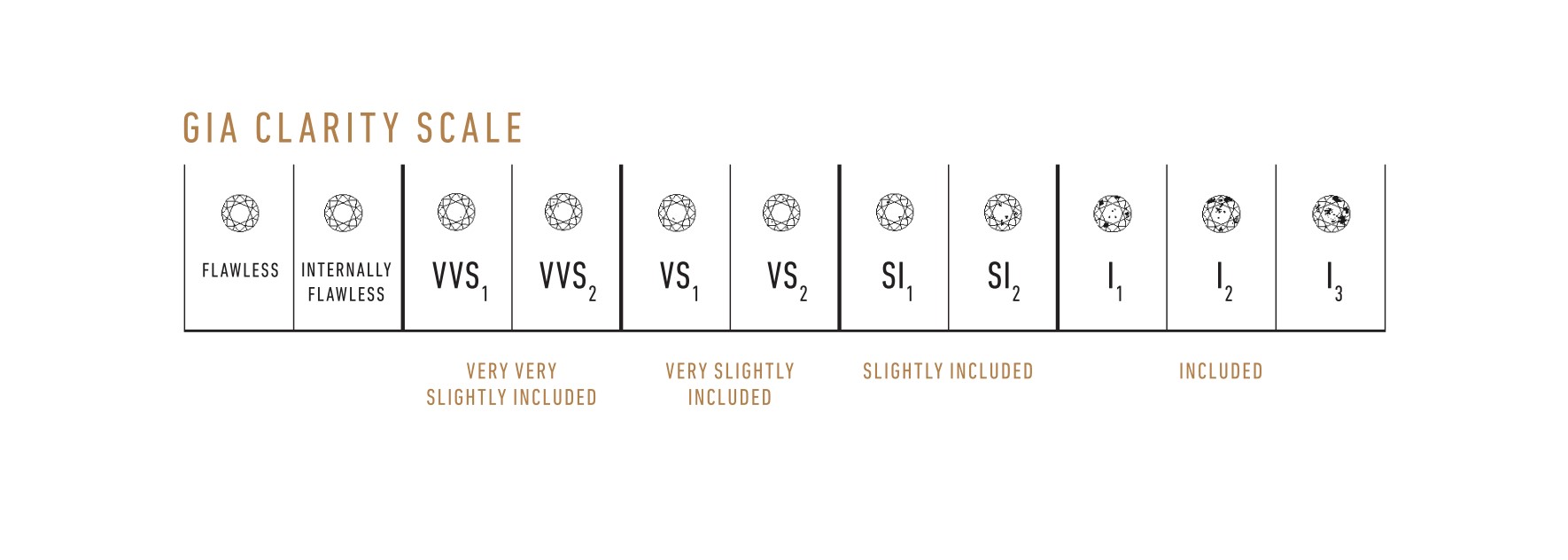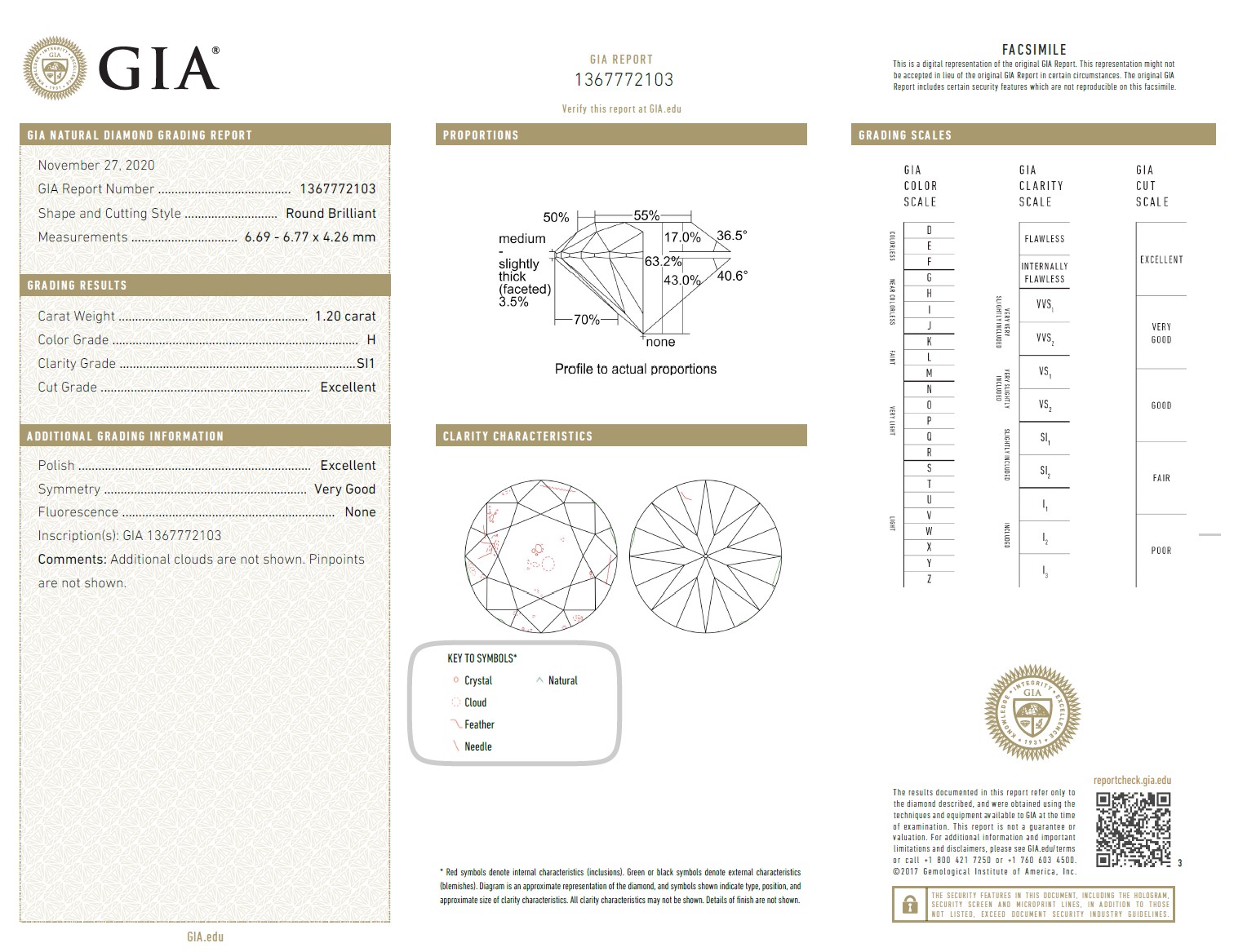Diamond Clarity
Diamond Clarity & Grading Chart
 Key Takeaways:
Key Takeaways:
- The number of natural flaws in a diamond determines the clarity grade of a diamond. There are two types of clarity factors in a diamond in general: blemishes (external flaws such as chips and scratches etc.) and inclusions (internal flaws such as crystals and feathers etc.). See more below on clarity types.
- Diamond clarity is a very technical factor in assessing the quality of a diamond. If you know how to play around it, clarity is one of the most flexible Cs among the 4Cs to compromise on while prioritizing the quality of a diamond. Therefore, it is essential to know what types of inclusions are better than others and what types to avoid.
- The location of the inclusion is also important. If it is located at the center of the diamond and on the table, it is considered a bad inclusion, especially if it is in the shape of large black crystals. If they are on the side of the girdle and are white feathers or pinpoints, such inclusions are generally preferred if they do not weaken the girdle, making it prone to chipping.
Our key Observations on the Diamond Clarity Scale:
The Gemological Institute of America (GIA) diamond clarity scale is divided into the following categories:
Flawless or FL: A diamond that has no blemishes and inclusions would fall within this category, also known as the best clarity grade.
Internally Flawless or IF: A diamond with extremely minimal external blemishes but no internal inclusions would fall within this category. Top clarity grade.
Very Very Slightly Included 1 or VVS1: VVS diamonds are extremely high clarity grade diamonds. You would need a microscope with a 60-100X magnification to locate the inclusions of a diamond in this clarity grade. Often, only trained gemologists can identify slight inclusions in this grade. Given that inclusions are considered natural birthmarks of a diamond, they are unique to each diamond, similar to our fingerprints. You can verify a diamond by the location and type of inclusions in it. Therefore, VVS1 diamonds are cherished like flawless diamonds since they have a unique inclusion pattern, thus creating a unique identity.
Very Very Slightly Included 2 or VVS2: Falling right next to VVS1 clarity grade, it is a very high clarity grade, which is why untrained individuals may not find inclusions in this clarity grade without a jeweler’s loupe. Gemologists would also need a microscope with higher magnification power to locate inclusions in this grade. If you can easily find inclusions with a loupe in a diamond, it is probably not a VVS grade diamond.
Very Slightly Included 1 or VS1: This is one of the best clarity grades in a diamond. VS1 diamonds are completely eye-clean and considered investment grade, similar to VVS diamonds. The boundary between VVS2 and VS1 is also very tight. While VVS would have a higher price tag, you cannot go with a VS1 clarity grade diamond.
Hint: If one diamond is VVS2 G and another VS1 F with all other factors being equal, go for the latter.
Very Slightly Included 2 or VS2: If you are on a budget and do not want to compromise on quality either, VS2 is the best clarity grade to consider. Diamonds in the VS2 clarity grade range are eye-clean, especially in less than 2-carat diamonds. It is an excellent option if you want a big diamond for a reasonable price without compromising the quality.
Slightly Included 1 or SI1: What we stated for VS2 is true for SI1 in the 1-carat range diamonds. SI1 diamonds in the 1-carat weight range are generally eye-clean if GIA grades them – other certification labs are not as reliable in the SI1 range. In the 2-carat range, SI1 diamond clarity should be closely inspected to ensure that the diamond is eye-clean or that the clarity grade does not overly affect the brilliance of a diamond. SI1 is a great budget option that can help you get a great diamond for a reasonable price that is still eye-clean to the naked eye.
Slightly Included 2 or SI2: There are SI2 diamonds in the 1-carat range that are eye-clean, while some, on the contrary, are not. The type and location of inclusions matter significantly. If they are white feathers and spread out inclusions across the diamond, the stone will be eye-clean. If they are big, black crystals, the diamond will not be eye-clean. In the 2-carat range or above, it is hard to find an excellent eye-clean SI2 diamond unless you are fortunate. Carefully inspect SI2 diamonds before buying.
Included 1-3 (I1, I2, I3): These are the lowest clarity grade diamonds in the GIA scale. Diamonds in this range are not eye-clean and would often have imperfect brilliance and fire because of too many flaws. I1 could still be a decent clarity grade for people with budget constraints, though I2/I3 would be pushing it.
Type of Inclusions:
There are several types of diamond inclusions and blemishes, but the most common ones that you should be familiar with include:


Bearding: These inclusions form at the girdle of a diamond during the bruting (cutting) process. If a girdle is bruted improperly, it will affect the clarity grade.
Graining: These inclusions are caused by the growth of crystals in a diamond. If the graining in a diamond is widespread, it can make the diamond look hazy.
Cavity: You should avoid large cavities because they can affect the overall structure of a diamond. A cavity is caused during the polishing process when crystals are moved, leaving a space or void.
Crystals: This is a very common inclusion in a diamond. Black crystals, such as carbons, should be avoided, though colorless white crystals are not as bad. The presence of large single crystals is also less desirable in a diamond.
Cloud: Clouds are generally a cluster of crystals and pinpoint in one area. When clouds are small, they are not a cause for concern. However, large clouds can affect the brilliance of the diamond by making it look hazy/cloudy. Avoid a diamond that states “clarity grade is based on clouds” in the GIA report implies that it is full of clouds and, therefore, not transparent.
Etch Channel: It is a hollow tunnel at the surface of a diamond that goes deep into its body like a channel. Though it can sometimes look like a laser-drilled treatment, it is a natural flaw.
Feather: It is caused by a fracture in a diamond and can be an issue if it is significant and affects a diamond’s structure, making it prone to chipping in the long term. Also, if the crack has coloration to it, it can affect the brilliance of the diamond. Small feathers are not a problem and preferred to, say, black crystals.
Manufacturing Remnant: It is a man made error in a diamond during the cutting process (the GIA calls it a manufacturing remnant) and happens when cutters use advanced machines to cut diamonds. These are merely residual/minor effects of the cutting process and should not be seen as clarity enhancement.
Pinpoints: These are tiny crystals (black or white) and are generally considered less harmful inclusions and, therefore, more desirable, primarily white pinpoints.
Twinning Wisps: These can be any inclusions (pinpoints, crystals, feathers, etc.) resulting from growth defects or distortion during the forming/growth process of a diamond over billions of years. They are not harmful if small.
Chips: These are generally caused during the cutting process. Small chips are not harmful and can occur during the polishing of the facets.
Indented Natural: Usually found near the girdle, it is a flaw left untouched beneath a diamond’s surface and while polishing it. It is usually a slight inclusion and does not harm the brilliance of a diamond.
Why Diamond Clarity is Important?
 Clarity of mind, clarity of soul, clarity of expressions, clarity of immersions, and clarity of diamonds: these sound very similar except for the relationship between clarity and the subject following it. The word clarity in itself is relatively self-explanatory.
Clarity of mind, clarity of soul, clarity of expressions, clarity of immersions, and clarity of diamonds: these sound very similar except for the relationship between clarity and the subject following it. The word clarity in itself is relatively self-explanatory.
In the case of a diamond, clarity is vital. A diamond’s ability to sparkle comes from its purity, allowing the light rays to cross through it, producing a rainbow and similar sparkle patterns. Therefore, the consistency, properties, presence, or absence of inclusions will count for the difference in diamonds’ clarity. Clarity summarizes the outside appearance of the inner being of a diamond.
Since diamonds go through a long birth process, most have birthmarks on the surface, leading to surface defects known as blemishes or internal defects called inclusions. There are different types of inclusions, including cloudy inclusions, pinpoint inclusions, cavities, cleavages, etc. Moreover, blemishes also occur in different shapes, such as nicks, pits, and breaks, etc. Almost all diamonds will have some of these clarity issues since they take millions of years to form. These issues can also result from the cutting process, which is very intense. Some of the clarity issues would be microscopic, while others are macroscopic. This is where the difference arises and hence the market value and demand variation of different diamonds.
There are different grades of clarity of diamonds you will encounter while searching for a good diamond. Clarity grades by GIA range from FL to I3, where FL stands for Flawless diamond with no inclusions and is the best diamond clarity. At the same time, I3 is the lowest grade of diamond clarity that has inclusions visible through an unaided eye. There are clarity enhancement techniques available in the market that can help uplift a diamond’s quality – most of such treatments are permanent. One such treatment is called “fracture filling diamonds,” which improves the clarity of a diamond by filling the breaks or problems in the diamond. Sometimes, lasers may also be used for such treatments. One of the main factors why diamonds are expensive is because they are natural. Once we alter that quality of a diamond, it changes its nature – the diamond is not natural anymore.
Clarity is a relative term, and very few diamonds would be FL or inclusion-free. Choose a diamond that you like, which sparkles best and is affordable. Stay above SI2 GIA clarity grade and avoid diamonds whose clarity is severely affected by clouds. Inclusions in a diamond are its birthmarks and are essential factors in confirming a diamond based on a GIA or AGS report if the diamond has no laser inscription. It is the reason why some people prefer VVS diamonds to Flawless diamonds.
Conclusion:
The GIA’s clarity grade scale is the industry standard for determining the clarity of a diamond. Clarity is among the four famous Cs (carat, cut, color & clarity) and a critical factor in determining a diamond’s price. Diamond clarity ranges from Flawless to I3 (or included 3). Consider diamonds with a clarity grade of SI2 or higher for under 1-carat stone and SI1 or above for 1.5ct or above. Avoid SI2 diamonds that have clarity grade solely based on clouds as they look ugly. However, clouds in VS clarity grade diamonds should not be a significant issue.
Credit: Sharif Khan on 20th Jul 2021
